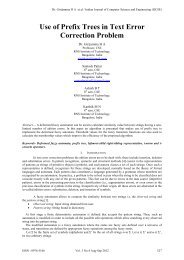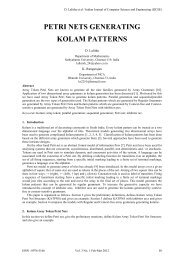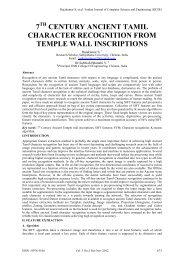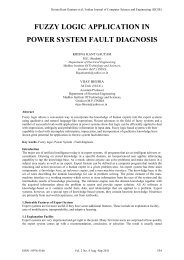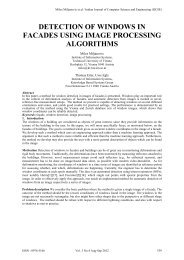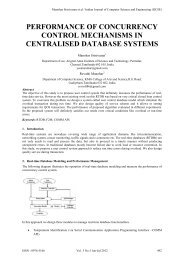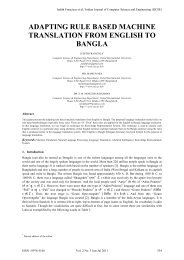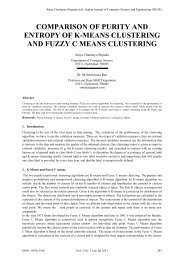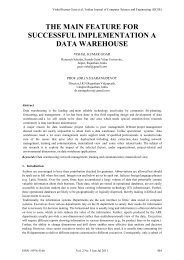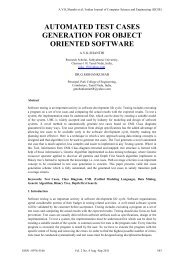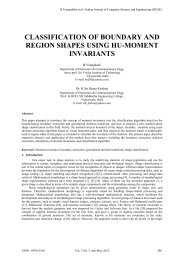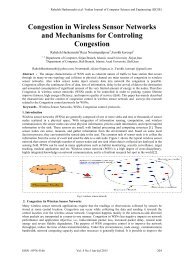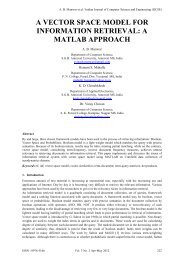data mining techniques and applications - Indian Journal of ...
data mining techniques and applications - Indian Journal of ...
data mining techniques and applications - Indian Journal of ...
Create successful ePaper yourself
Turn your PDF publications into a flip-book with our unique Google optimized e-Paper software.
Bharati M. Ramageri / <strong>Indian</strong> <strong>Journal</strong> <strong>of</strong> Computer Science <strong>and</strong> Engineering<br />
Vol. 1 No. 4 301-305<br />
Pattern Identification: Once <strong>data</strong> is explored, refined <strong>and</strong> defined for the specific variables the second step<br />
is to form pattern identification. Identify <strong>and</strong> choose the patterns which make the best prediction.<br />
Deployment: Patterns are deployed for desired outcome.<br />
2. Data Mining Algorithms <strong>and</strong> Techniques<br />
Various algorithms <strong>and</strong> <strong>techniques</strong> like Classification, Clustering, Regression, Artificial<br />
Intelligence, Neural Networks, Association Rules, Decision Trees, Genetic Algorithm, Nearest Neighbor<br />
method etc., are used for knowledge discovery from <strong>data</strong>bases.<br />
2.1. Classification<br />
Classification is the most commonly applied <strong>data</strong> <strong>mining</strong> technique, which employs a set <strong>of</strong> pre-classified<br />
examples to develop a model that can classify the population <strong>of</strong> records at large. Fraud detection <strong>and</strong> creditrisk<br />
<strong>applications</strong> are particularly well suited to this type <strong>of</strong> analysis. This approach frequently employs<br />
decision tree or neural network-based classification algorithms. The <strong>data</strong> classification process involves<br />
learning <strong>and</strong> classification. In Learning the training <strong>data</strong> are analyzed by classification algorithm. In<br />
classification test <strong>data</strong> are used to estimate the accuracy <strong>of</strong> the classification rules. If the accuracy is<br />
acceptable the rules can be applied to the new <strong>data</strong> tuples. For a fraud detection application, this would<br />
include complete records <strong>of</strong> both fraudulent <strong>and</strong> valid activities determined on a record-by-record basis.<br />
The classifier-training algorithm uses these pre-classified examples to determine the set <strong>of</strong> parameters<br />
required for proper discrimination. The algorithm then encodes these parameters into a model called a<br />
classifier.<br />
Types <strong>of</strong> classification models:<br />
<br />
<br />
<br />
<br />
<br />
Classification by decision tree induction<br />
Bayesian Classification<br />
Neural Networks<br />
Support Vector Machines (SVM)<br />
Classification Based on Associations<br />
2.2. Clustering<br />
Clustering can be said as identification <strong>of</strong> similar classes <strong>of</strong> objects. By using clustering <strong>techniques</strong> we can<br />
further identify dense <strong>and</strong> sparse regions in object space <strong>and</strong> can discover overall distribution pattern <strong>and</strong><br />
correlations among <strong>data</strong> attributes. Classification approach can also be used for effective means <strong>of</strong><br />
distinguishing groups or classes <strong>of</strong> object but it becomes costly so clustering can be used as preprocessing<br />
approach for attribute subset selection <strong>and</strong> classification. For example, to form group <strong>of</strong> customers based on<br />
purchasing patterns, to categories genes with similar functionality.<br />
Types <strong>of</strong> clustering methods<br />
<br />
<br />
<br />
<br />
<br />
Partitioning Methods<br />
Hierarchical Agglomerative (divisive) methods<br />
Density based methods<br />
Grid-based methods<br />
Model-based methods<br />
ISSN : 0976-5166 302



